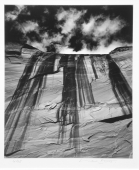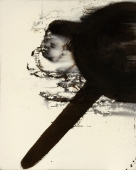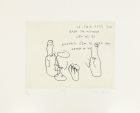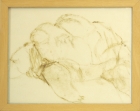
Artist | Sigmar Polke (1941 - 2010)
https://www.artist-info.com/artist/Sigmar-Polke
 Artist Portfolio Catalog
Artist Portfolio Catalog
| Image | Artist | Title | Year | Material | Measurement | ||||||||||||||||||||
|---|---|---|---|---|---|---|---|---|---|---|---|---|---|---|---|---|---|---|---|---|---|---|---|---|---|
 |
Sigmar Polke | B-Mode | 1987 | latex paint on transparent drapery | 300,5 x 224 cm | ||||||||||||||||||||

Sigmar Polke (1941 - 2010)B-Mode
|
|||||||||||||||||||||||||
 |
Sigmar Polke | Kartoffelköppe (Mao + LBJ) | 1968 | oil on textile | 90 x 110 cm | ||||||||||||||||||||

Sigmar Polke (1941 - 2010)Kartoffelköppe (Mao + LBJ)
|
|||||||||||||||||||||||||
 |
Sigmar Polke | Interieur | 1965 | oil on canvas | 160,1 x 140,1 cm | ||||||||||||||||||||

Sigmar Polke (1941 - 2010)Interieur
|
|||||||||||||||||||||||||
Biography (english / deutsch)
Biography (english / deutsch)
Born in Silesia in Poland in 1941, Sigmar Polke came to West Germany in 1953. He studied at the Düsseldorf Art Academy from 1961 to 1967, and lives now in Cologne.
Sigmar Polke wird 1941 in Oels, Schlesien geboren; er übersiedelt nach Westdeutschland und studiert 1961-67 an der Düsseldorfer Kunstakademie. Zusammen mit Gerhard Richter und Konrad Lueg gründet er 1963 die Gruppe des "Kapitalistischen Realismus". Die Galerie René Block in West-Berlin zeigt 1966 eine erste Einzelausstellung. Polke erhält den Baden-Badener Kunstpreis der deutschen Jugend. In den 60er Jahren arbeitet er unter anderem mit einer von Roy Lichtenstein übernommenen Rasterpunkttechnik, persifliert Werke der älteren bis aktuellen Kunstgeschichte, malt ebenso abstrakt wie gegenständlich auf gemusterten Stoffen. 1977 wird Polke Professor an der Hochschule für bildende Künste in Hamburg. Die komplexe Stilvielfalt behält er in den 70er und 80er Jahren bei. Er beginnt in einigen Werkserien mit unerprobten Farbstoffen, Mineralien und Chemikalien zu experimentieren. Als Polke 1986 im Deutschen Pavillon auf der Biennale in Venedig die Wände mit Hydro- und Thermofarbe überzieht, die auf Temperatur und Luftfeuchtigkeit reagieren, gewinnt er den Goldenen Löwen der Biennale. Eine große Retrospektive findet 1997 in der Kunst- und Ausstellungshalle der Bundesrepublik Deutschland in Bonn statt.
Text von Diana Ebster
About the work (english / deutsch)
About the work (english / deutsch)
In General
He is, as Bice Curiger puts it, "an encyclopaedist of the visible and the visibly possible." Since the mid-Sixties, he has explored the picture as well as the material; the material was of interest where it gradually becomes transformed into an image and he investigates specifically those intrinsic pictorial laws which become manifest in its material qualities.
Polke derives a mischievous pleasure out of all this; after all, he is explorer, poet and alchemist. He does not observe himself, he observes what happens an the winding paths which he chooses to follow: he manipulates, structures, dares to look at the cosmos and discovers that the cosmos spreads out before our very door. Quotation und image together create a „painterly“ transparency, with the quote always stemming from some printed original, which, when blown up, unites closeness and distance, clear definition and indeterminacy, secret and revelation. The view we gain by dint of the enlarged matrix conveys to us a sense of the material of which dreams are made (perhaps even the dreams of the material). The result of all of this is that a mysterious dialogue between artist and work ensues, which can often drag on for several years as he repeatedly wrestles with it.
Interior
Interieur (Interior), produced in 1965, is the first picture of the group. What at first sight seems an apparently innocent atmospheric picture, nonetheless has a decidedly wily side to it. We are shown a stylish salon with a view of a balcony and mountains, but we cannot be sure if the scene has been taken from a hotel brochure, modeled on a country mansion in „Better Homes and Gardens" or if the artist was perhaps even inspired by Adolf Menzel’s The Balcony Room of 1845. The picture undermines itself, because it seems to float between authenticity, luxury and kitsch: a state of floating quite unlike that to be found in American-Mexican Border.
B-Fashion
A coat of synthetic resin renders in B-Fashion the pieces of cloth, sewn together diagonally, translucent, so that the stretcher for the canvas is not only visible but also becomes part of the artwork. The figure in question is a pin-up girl on her knees, which Polke has cut out of a magazine and enlarged. She is looking back seductively over her shoulder at us, revealing half of her behind. A luxuriant flowery pattern, kept tone in tone, softly merges into her bosom.
The erotically charged moment here remains present as does the spatial element, which takes the shape of a subdivision into window frames that initially puzzle us, because the curved curtains are blotted out. The transparency of the pin-up girl resembles a diffuse curtain: you sense more than you actually see.
However, this does not answer the question why Polke chose this motif. It is certainly prototypical in its particular way: the erotic tradition has always relied on partial exposure, a partial strip. But I believe that the behind, only half of which is exposed, again leaves something halfway undecided. The movement of the girl’s hand which exposes her behind is not only enticing, but also creates distance. Leaving something undecided means to create an interim space, and indeterminacy does not always match our ideas. It may be a game to keep someone agonizingly in suspense, but at some point the game is up. The question: "Now what is the case - this, or that?“ was also the basis of the famous and vitriolic debate between Winckelmann and Lessing on the statue of Laocoon and his sons. Given that the sculpture depicts supreme tension (struggle, pain), the question is whether the sculptural describes the equivalent shortly before or shortly after the climax. This aesthetic question could be raised with regard to a weight-lifter, or, for that matter, with reference to Polke’s pin-up girl and her panties. Thus, a banal motif, coupled with a specific element of action, leads to the question of our attitude to indeterminacy: as an ironic metaphor. For this indeterminacy contains the determinate, the definite, within it. Put differently: the path is the goal. This is true of Polke’s oeuvre as a whole. His constant drive to explore has not only kept his horizons free but also kept the depths of the cosmos and the human soul open, and indeterminate.
German text by Jean-Christophe Ammann / Translation by Jeremy Gaines
(Extract - Full printed version available in the Museum)
MMK - Museum für Moderne Kunst, Frankfurt am Main
Allgemeines
Er ist, wie Bice Curiger sagt, „ein Enzyklopädist des Sichtbaren und des sichtbar Möglichen.“ Er erforscht seit Mitte der sechziger Jahre sowohl das Bild als auch das Material: Das Material interessiert ihn dort, wo es sich prozeßhaft in ein Bild verwandelt, und er befragt jene Gesetzmäßigkeiten des Bildes, die sich in ihren materialen Eigenschaften offenbaren.
In all dem entwickelt Polke ein diebisches Vergnügen, denn er ist Kundschafter, Poet und Alchemist zugleich. Er beobachtet sich nicht; er beobachtet, was sich auf den verschlungenen Pfaden, die er beschreitet, ereignet: Er manipuliert, strukturiert, wagt den Blick in den Kosmos und stellt fest, daß sich dieser vor unserer eigenen Tür ausbreitet. Zitat und Bild schaffen eine „malerische“ Transparenz, wobei das Zitat stets einer gedruckten Vorlage entstammt, die in der starken Vergrößerung Nähe und Ferne, Bestimmtheit und Unbestimmtheit, Geheimnis und Offenbarung vereint. Der “durch“ den vergrößerten Raster gewährte Blick führt uns gleichsam den Stoff, aus dem die Träume gemacht sind, vor Augen (vielleicht auch, die Träume des Stoffs). Daraus ergibt sich jener geheimnisvolle Dialog zwischen Künstler und Werk, der sich in der weiteren Bearbeitung oftmals über mehrere Jahre hinzieht.
Interieur
Die Arbeit Interieur (1965) ist ein brav anmutendes Stimmungsbild, das jedoch ausgesprochen hinterhältig ist, denn was wir zu sehen bekommen ist ein stilvoller Salon mit Ausblick auf Balkon und Berg, von dem wir nicht wissen, ob die Inszenierung einem Hotelprospekt entstammt, einem Landhaus aus der Zeitschrift "Schöner Wohnen“ zuzuordnen ist, oder ob der Künstler vielleicht sogar durch Das Balkonzimmer (1845) von Adolf Menzel inspiriert wurde. Das Bild hebt sich selbst aus den Angeln, weil es in einem Schwebezustand Authentizität, Luxus und Kitsch vereint: Ein Schwebezustand, der in ganz anderer Art in Amerikanisch-Mexikanische Grenze zu finden ist.
B-Mode
Eine Kunstharzbeschichtung in B-Mode (1987) macht die diagonal aneinandergenähten, vorgedruckten Stoffe durchscheinend, so daß die Keilrahmenkonstruktion nicht nur sichtbar, sondern auch Teil des Werks selbst wird. Die Figur zeigt ein knieendes Pin-up-Girl, das Polke aus einer Zeitschrift heraus vergrößert hat. Über die Schulter blickend, ihr Gesäß zur Hälfte entblößend, schaut sie verführerisch dem Betrachter entgegen. Ein üppiges, Ton in Ton gehaltenes Blütenmuster geht sanft in ihren Busen über. Das erotisierende Moment bleibt ebenso erhalten wie das räumliche, in Form der Fensterrahmenunterteilung, die durch die Ausblendung der geschwungenen Vorhänge zuerst ein Rätsel aufgibt. Die Transparenz des Pin-up-Girls gleicht einem diffusen Vorhang: Man ahnt mehr als man sieht.
Jedoch stellt sich die Frage, weshalb Polke dieses Bildmotiv gewählt hat. Sicher, es ist in seiner Art prototypisch: Das partielle Enthüllen und Entblößen liegt der erotischen Tradition zugrunde. Dennoch möchte ich behaupten, daß das zur Hälfte entblößte Gesäß wiederum auf „halbem Weg etwas offenläßt“. Die Handbewegung, die das Entblößen bewirkt, lädt ein und markiert Distanz: Das Offenlassen entspricht einem Zwischenbereich, Unbestimmtheit entspricht nicht immer unserer Vorstellung: Jemanden „auf die Folter spannen“ mag ein Spiel sein, aber das Spiel muß ein Ende haben. Die Frage: „Wie ist es nun - so oder so?“ liegt auch der vehement geführten Diskussion zwischen Winckelmann und Lessing über die Laokoon-Gruppe zugrunde. Da die Skulptur Ausdruck höchster Spannung ist (Kampf, Schmerz), galt es herauszufinden, ob dieses Moment kurz vor oder kurz nach dem Höhepunkt sein bildnerisches Äquivalent findet. Diese ästhetische Frage ließe sich auch bei einem Gewichtheber stellen und ebenso bei Polkes Pin-up-Girl und dessen Slip. So führt ein banales, mit einem spezifischen Handlungsmoment verbundenes Bildmotiv auch zur Frage der Einstellung dem Unbestimmten gegenüber: als ironische Metapher. Die Rede ist von einer Unbestimmtheit, die das Bestimmte enthält. Oder anders ausgedrückt: Der Weg ist das Ziel. Dies kennzeichnet das Schaffen von Sigmar Polke. Sein kontinuierlicher Forschungstrieb hat nicht nur seinen Horizont frei-, sondern auch die Tiefen des Kosmos und die Seele des Menschen offengehalten.
Text von Jean-Christophe Ammann
(Auszug - Der vollständige Text ist als Informationsblatt beim Museum erhältlich)
MMK - Museum für Moderne Kunst, Frankfurt am Main
Bibliography
Bibliography
Sigmar Polke und Achim Duchow. Kunsthalle Kiel und Schleswig-Holsteinischer Kunstverein 1975.
Sigmar Polke. Bilder Tücher Objekte - Werkauswahl 1962-1971. Ausstellungs-Katalog Kunsthalle Tübingen, Kunsthalle Düsseldorf, Stedelijk van Abbe-Museum Eindhoven 1976.
Catalogue, Museum Boymans-van Beuningen Rotterdam, 1983 and Städtisches Kunstmuseum Bonn, 1984
Catalogue, Kunsthaus Zürich, 1984
Catalogue, San Francisco Museum of Modern Art, 1991
Catalogue, Stedelijk Museum Amsterdam, 1992
Sigmar Polke. "Die drei Lügen der Malerei". Ausstellungs-Katalog Ausstellungshalle der Bundesrepublik Deutschland, Verlag Cantz 1997.
 Exhibition Announcements
Exhibition Announcements
| Image | Opening | Closing | City/Country | Exhibition Place | Exhibition Title | ||||||
|---|---|---|---|---|---|---|---|---|---|---|---|
 |
Mar 13, 2015 07:00 pm | Jul 05, 2015 | Köln | Museum Ludwig | Alibis: Sigmar Polke | ||||||

Sigmar Polke, Freundinnen, 1965/1966, emulsion paint on canvas, 150 × 190 cm, Froehlich Collection, Stuttgart, © 2015 The Estate of Sigmar Polke / VG Bild-Kunst Bonn, 2015, Photo © Froehlich Collection Archive Köln Museum LudwigAlibis: Sigmar PolkeRetrospektive
|
|||||||||||
 |
Oct 11, 2013 08:00 pm | Dec 01, 2013 | London | Dairy Art Centre | Island | ||||||

London Dairy Art CentreIsland
Weiwei AI - John M Armleder - Sylvie Auvray - Tom Benson - Valentin Carron - Jake & Dinos (*1966 / *1962) Chapman - George Condo - Ann Craven - Thomas Demand - Lijun FANG - Urs Fischer - Théodore Fivel - Sylvie Fleury - [Thomas Poulsen] FOS - Cyprien Gaillard - Gunjan Gupta - Anthea Hamilton - Thilo Heinzmann - Terence Koh - Sergej Jensen - Rashid Johnson - Per Kirkeby - Adriana Lara - [Franck Leibovici *1975 & Diemo Schwarz] Leibovici & Schwarz - Ursula Mayer - Takashi Murakami - Order of the Third Bird - Jagannath Panda - Maï-Thu Perret - Sigmar Polke - Laure Prouvost - R. H. Quaytman - Ugo Rondinone - Sterling Ruby - Tomás Saraceno - Julian Schnabel - Cindy Sherman - Dirk Skreber - Haim Steinbach - Rirkrit Tiravanija - [Jiten Thukral *1976 & Sumir Tagra *1979] Thukral & Tagra - Andro Wekua - Douglas White - Fanzhi Zeng - |
|||||||||||
 offers / Requests offers / Requests  |
Learn more about this service |
|---|
 Visualization |
Learn more about this service | ||
|---|---|---|---|

Interested in discovering more of this artist's networks?
3 easy steps: Register, buy a package for a visualization, select the artist.
See examples how visualization looks like for an artist, a curator, or an exhibition place: Gallery, museum, non-profit place, or collector.

Exhibition History

|
SUMMARY based on artist-info records. More details and Visualizing Art Networks on demand. Venue types: Gallery / Museum / Non-Profit / Collector |
||||||||||||
| Exhibitions in artist-info | 403 (S 100/ G 303) |
Did show together with - Top 5 of 4499 artists (no. of shows) - all shows - Top 100
|
||||||||||
| Exhibitions by type | 403: 137 / 143 / 113 / 10 | |||||||||||
| Venues by type | 244: 82 / 84 / 73 / 5 | |||||||||||
| Curators | 163 | |||||||||||
| artist-info records | May 1963 - Jun 2025 | |||||||||||
|
Countries - Top 5 of 19 Germany (211) United States (72) France (20) Switzerland (19) United Kingdom (15) |
Cities - Top 5 of 101 New York (46) Köln (36) Berlin (29) Frankfurt am Main (26) Hamburg (17) |
Venues (no. of shows )
Top 5 of 244
|
||||||||||
Curators (no. of shows)
Top 5 of 163
|
| Fondazione Prada | G | Apr 2025 - Jun 2025 | Milano | (4) | +0 | |
| Pfeffer, Susanne (Curator) | +0 | |||||
| Galerie Thomas | G | Apr 2024 - Sep 2024 | München | (36) | +0 | |
| Museum Kunstpalast | G | Feb 2024 - May 2024 | Düsseldorf | (82) | +0 | |
| Conze, Linda (Curator) | +0 | |||||
| Pinakothek der Moderne | G | Dec 2023 - Mar 2024 | München | (62) | +0 | |
| Kunze, Franziska (Curator) | +0 | |||||
| Bauer, Franziska (Curator) | +0 | |||||
| Museum Frieder Burda | G | Dec 2022 - Apr 2023 | Baden-Baden | (31) | +0 | |
| Kunstmuseum Bonn | G | Oct 2022 - Jan 2023 | Bonn | (181) | +1 | |






































